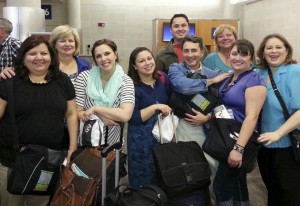 By Marie Wood The Land Associate Editor |
By Marie Wood The Land Associate Editor |
Every May, migrant farm workers come to Minnesota to work the fields.
The jobs vary — picking rocks, hoeing weeds, seeding and sorting potatoes, picking apples, dairy farming or working in the vegetable packing plants. Packing plants in Minnesota pack peas in June until mid-July when they begin corn packing until mid-October.
A large portion of the migrant workers in Minnesota come from the Rio Grande area of Texas. There are also Sudanese, Guatemalan and Mexican families.
To help migrant farm workers’ children overcome the challenges of moving to new schools, missing school, poverty, and language barriers, the national Migrant Education Program provides educational and support services to migrant children from age 3-21.
“We’re trying to connect the dots so these kids don’t fall through the cracks,” said Noemi Treviño, education specialist at the Minnesota Department of Education. “We want to make sure that migrant children receive the same services that their counterparts receive. They are highly mobile, so they have academic gaps.”
Making sure the students receive full credits becomes more crucial in order to graduate, she said. “The bottom line is we want to make sure we have an educated community that’s empowered to contribute to our economy,” Treviño said.
Assisting migrant families for almost 50 years, the program is authorized and funded by Title I, Part C of the Elementary and Secondary Education Act of 1965. Part C is titled Education of Migratory Children. For pregnant mothers and children from birth to age 5, Head Start and Early Head Start provide services. Support services such as free school food service, health services and screenings are beneficial. Many migrant children tend to be under- or over-immunized.
Since 1967, Tri-Valley Opportunity Council has played a key role in providing migrant services. Employing a network of recruiters and family advocates in six regions across Minnesota, Tri-Valley recruits and enrolls families for Head Start and Title I services. The ability to speak Spanish is a requirement. Partnering with Head Start and Early Head Start, Tri-Valley operates 14 Migrant and Seasonal Head Start and Early Head Start centers in Minnesota and one center in North Dakota. Typically, the centers are open May to December.
Laurie Coleman, Head Start director for Tri-Valley Opportunity Council in Crookston, said an average of about 1,000 children and pregnant mothers are served annually. With each family, Tri-Valley recruiters and family advocates create a transition packet so the families can get their screenings, health and school records into the next education setting, Coleman said.
“Some may stop at other states along the way,” she said.
Enrollment has declined. Roundup weed killer, which came out in the 1970s, is responsible for the biggest decline in migrant workers. With fewer weeds to hoe, fewer workers are needed. Along with teaching parents about children’s health and development, Tri-Valley educates parents on the dangers of herbicides and pesticides to children.
“That’s our goal — to keep the kids out of the fields and into school. That’s why we’re here,” Coleman said.
Rewards
Amber Higgins, assistant identification and recruitment manager for Tri-Valley Opportunity Council in Apple Valley, thinks like a farmer, with an eye on the weather.
In spring and early summer, she searched online for articles on spring flooding. This summer, she knew a lot of her families would be out of work when a hail storm in Brainerd turned an apple orchard into apple sauce.
Higgins knows that weather is a harbinger of when migrant workers will arrive in Minnesota, where they will work and how long they will stay. This season, Minnesota’s long winter and wet spring led to work starting later — and not at all in some places. Many families arrived to work only to return home, she said.
In 2012-2013, Tri-Valley Opportunity Council identified 1,767 migrant children in Minnesota.
When workers migrate to different areas, Tri-Valley has to be creative in providing services to a changing population. That means flexibility in setting up centers and classrooms. To qualify for services, families must be working seasonal jobs that are agriculture-based.
Some school districts, such as Sleepy Eye and Rochester, offer summer school sites.
“Summer programs offer them time to make up,” Higgins said. “When school starts, they are right ahead with their classmates.”
There can be a lag time between identifying families and enrolling them for services. Often, migrant families do not have all the required documents. That’s why transition plans are so important.
“When they arrive at the next place,” Higgins said, “one goal of our program is that they don’t have to repeat this stuff and wait to get into school.”
In recent years, many families have settled out of migrant life, Higgins said. She pointed to an oil boom in Texas, a state many consider to be their home base, as one reason.
“That’s what we want for families — more security and stability for their entire life,” Treviño said.
For Higgins, the greatest success is in getting migrant children kindergarten-ready and graduating. Longtime recruiters are instrumental in keeping young people motivated to stay in school, she said. Higgins relayed the story of a recruiter who had worked with a family for 10 years when one of the kids told her, “I finally graduated.’’
“Every family that is being served gets support,” Higgins said. “Title kids are staying on track to graduate.”
Part 2 of a two-part series on support for the children of migrant farmworkers.
